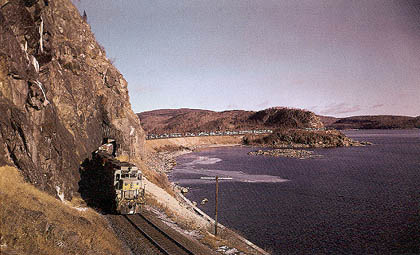|
Winter
2003/2004

Canadian Pacific
Railway Employee Communications
Room 500 401-9th Ave S.W. Calgary AB
T2P 4Z4
A Whole New
Generation
By Jonathan Hanna - Corporate
Historian

Canada's only
two GP30 locomotives haul a fast freight along the north shore of Lake Superior with
a load of new cars and trucks, in the fall of 1964.
General Motors'
trade-in program launches CPR'S second wave of newer model diesel
locomotives
Canada's major railways had completely dieselized by the early 1960s. The capital,
operations, and maintenance savings were astronomical - roughly
two-thirds over steam operations. CPR needed 2,290 steam locomotives to
operate a 15,230 mile (24,510 Km) system in 1924. It handled a slightly larger 16,900
mile (27,200 Km) system with only 1,054 diesel-electric locomotives in
1961.
By the time the system was renewed and completely dieselized, new motive power
purchases in North America were falling off dramatically. To stimulate purchases the
two major Canadian manufacturers - General Motors (GM) and Montreal Locomotive Works
(MLW) - came up with a trade-in policy mimicking the automotive world.
Old motive power could be traded-in on newer models, but unlike
automotive trade-ins, certain components from the traded-in
locomotives would be used in the manufacture of the new ones.
To replace first generation power in the early 1960s, GM introduced a new main line
locomotive - model GP30. Following its existing series of general purpose, or GP
locomotives, GM used the model number "30" to tout the fact that there were
no fewer than 30 improvements made over the previous model. As a further ploy, GM
re-introducedsome "styling" into the manufacture of
diesel-electric locomotives. GP30 phase ones rolled off the assembly
line practically devoid of unsightly louvers on their hoods, and sporting a rakish
"comb-back" sweeping from the number boards above the cab and
over much of the hood, covering the dynamic brake resistors and part of the
centralized air system.
To try out the trade-in program CPR used two locomotives involved in a
wreck. Some components in the two GM units - F9B No. 1902 and F7B No. 1910 - were used
in the manufacture of 8200 and 8201, Canada's only GP30 locomotives. They were
Canada's first "second generation" locomotives, as well as the first to be
turbocharged. Outshopped 30 Mar 1963, they were pressed into freight
service between their original terminal points of Montreal, Toronto and Calgary. The
two turbocharged 2,250-h.p. locomotives fared well enough to persuade
CPR of the benefits of trade-ins.
Soon after the two GP30's were delivered, the 2,500-h.p. GP35 model
replaced the GP30 in GM's catalog. CPR ordered a dozen of that model for delivery in
1964.
CPR's GP30's, delivered as Nos. 8200 and 8201, were renumbered 5000 and 5001 in April
1965. They were tied up unserviceable in 1995 (No. 5001) and 1996 (No. 5000) and
retired on 3 Jun 1998.
No. 5001 was sold to a US used locomotive broker. It is now refurbished and repainted
in blue with white nose stripes and is still numbered 5001.
CPR sold No. 5000 to the Canadian Rockies Railroad Museum Foundation at the end of
1998. It is being preserved for eventual restoration and display in its original
maroon-and-grey paint scheme and number: 8200.
| |
Vital
Statistics
|
Numbers
|
8200-8201
|
Class
|
DRS-22a
|
Builder
|
General Motors Diesel
Division
|
Outshopped
|
30 Mar 1963
|
Builder's Model
|
GP30
|
Horsepower
|
2,250
|
Cylinders
|
16
|
Axles
|
4
|
Maximum speed
|
65 mph (105 Kph)
|
Length
|
56 ft. - 2 in. (17.1 m)
|
Height
|
15 ft. - 11 in. (4.85 m)
|
Weight
|
259,000 lbs. (117,482 kg)
|
Cost
|
$263,740
|
This Momentum article is
copyright 2004 by Canadian Pacific Railway and is reprinted here with their
permission. All photographs, logos, and trademarks are the property of the Canadian
Pacific Railway Company.
©
2005 William C. Slim
http://www.okthepk.ca
|